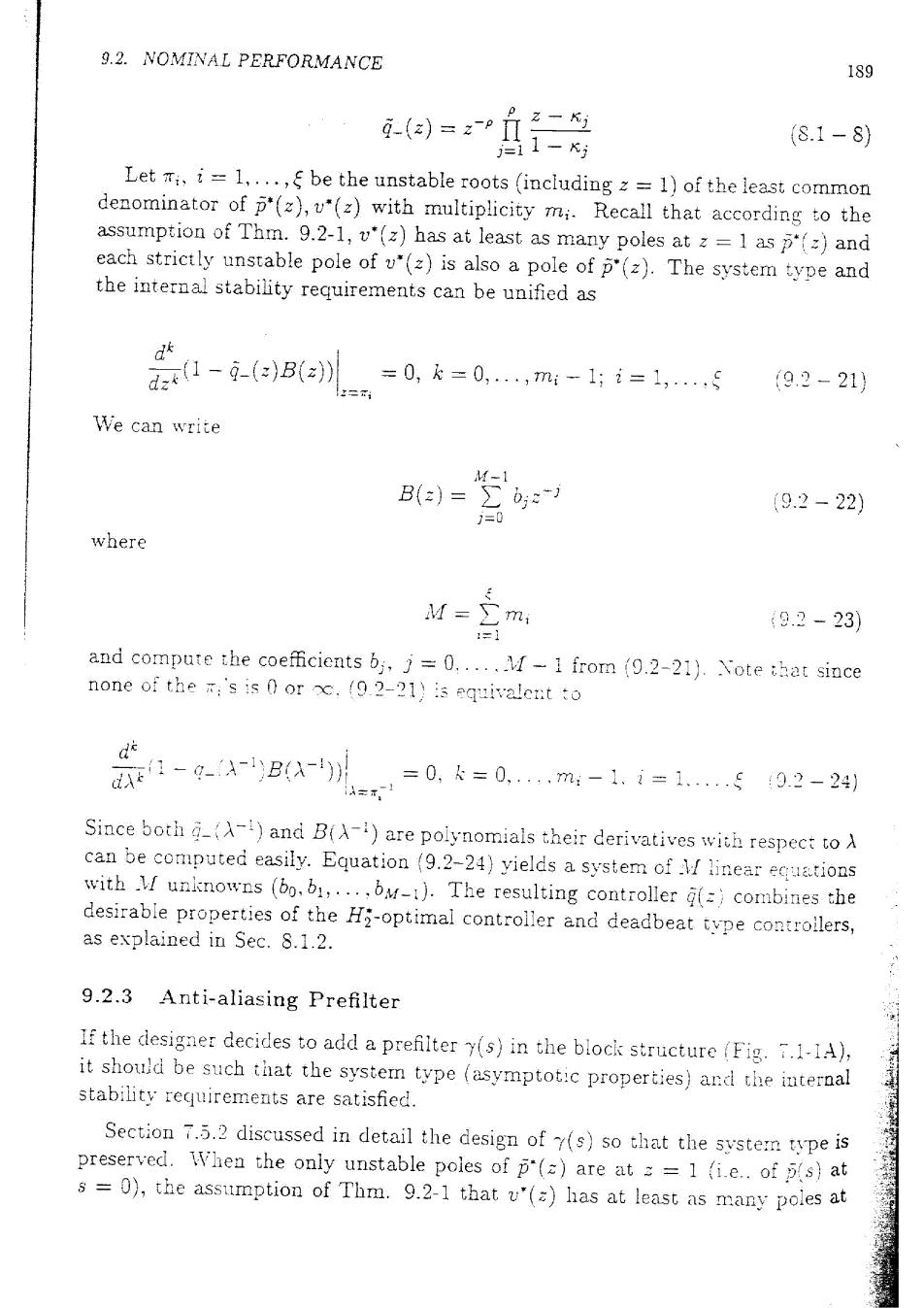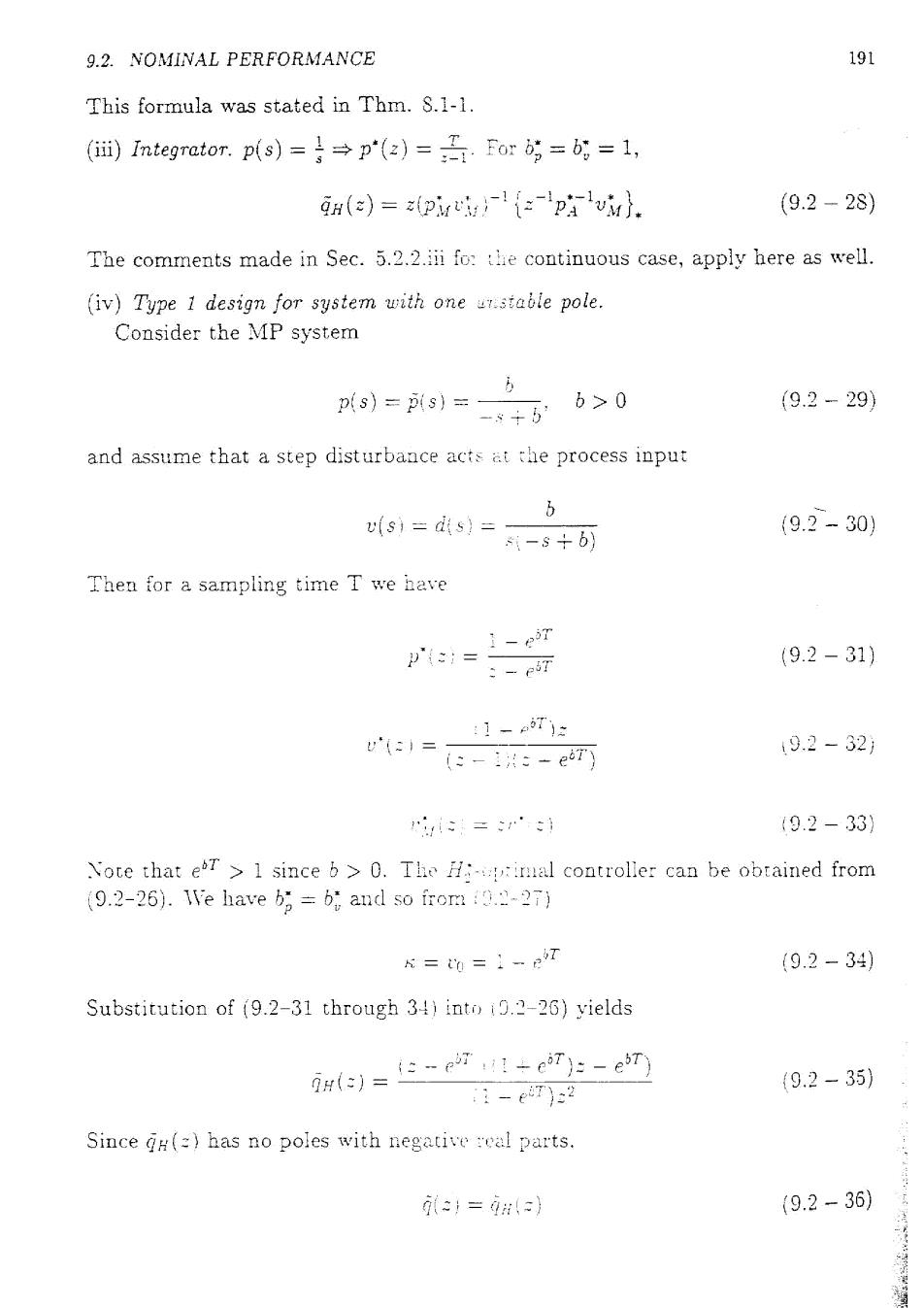
9.2.NOMINAL PERFORMANCE 189 = 之一1 (8.1-8) Letπ:,;=l,.,ξbe the unstable roots(including z=l)of the least common denominator of p*(z),v"(z)with multiplicity mi.Recall that according to the assumption of Thm.9.2-1,v"(z)has at least as many poles at z=1 asp"()and each strictly unstable pole of u"(z)is also a pole of p"(z).The system type and the internal stability requirements can be unified as dk 1-g-(eB(a》=0,k=0,m-1:i=1,…5 (9.2-21 We can write -1 B()=∑ 0 9.2-22) where M=∑m: 9.2-23) =1 and compute the coefficients bj,j=0.....-1 from (9.2-21).Note that since none of the r:'s is 0 or c.(9.2-21)is equivalent to d 1g-ABfA) =0,k=0,..m:-1、i=1..502-24) Since both (-)and B(A-)are polynomials their derivatives with respect toA can be computed easily.Equation (9.2-24)yields a system of linear equations with M unknowns (bo,b1,...,bM-1).The resulting controller (=combines the desirable properties of the H2-optimal controller and deadbeat type controllers, as explained in Sec.8.1.2. 9.2.3 Anti-aliasing Prefilter If the designer decides to add a prefilter y(s)in the block structure (Fig.7.1-1A), it should be such that the system type (asymptotic properties)and the internal stability requirements are satisfied. Section 7.5.2 discussed in detail the design of (s)so that the systemn type is preserved.When the only unstable poles of p"()are at-1 (i.e..of p(s)at s =0),the assumption of Thm.9.2-1 that v"(z)has at least as many poles at

190 CHAPTER 9.SISO DESIGN FOR UNSTABLE SAMPLED-DATA SYSTEMS =1 as p*(),ensures that the internal stability conditions are satisfied for any prefilter which preserves system type. When p"(z)has unstable poles in addition to those at z=1,it is not a simple manner to design y such that condition (ii)of Thm.9.1-1 is satisfied after g(z) has been determined as outlined in the preceding two sections.The preferred approach is to design y(s)first according to Sec.7.5.2.Then one computes p(z)and uses it instead of p'()in Thm.9.2-1 in order to obtain q(z)and subsequently (=)However.this means that the objective function which is minimized is not the one given by 9.2-9)but o、=1-())2(e3 (9.2-25) which does not correspond to the true physical problem.Usually (9.2-25)is a good approximation of(9.2-9). 9.2.4 Design for Common Input Forms In this section we shall examine the -optimal controller (=)given by (9.2-4). for specific systems and inputs. (i)MP System. When p(s)is MP and also strictl proper (all physical systems are strictly proper).p"(=)will have a delay of one unit because of sampling.Hence p= :-1.pi sp'.and (9.2-1)viclds gH=p)-6-c)1(o》-l6u-K =p,:-b8 0.2-26) where K is the constant term inrhe partial fraction expansion of (b)b Equivalently.sinceare se:proper.is the product of the constant terms of the PFE's of b:-..After some algebra we obtain K=Π 1-万 (9.2-27)1 where,,are defined in Thm.2.2-1 and vo is the first non-zero coefficient obtained by long division ofal to the constant term in the PFE of viM(a)》. (ii)Stable System.b=b=1 H(a)=pi)1{:pv} (S.1-5)

9.2.NOMINAL PERFORMANCE 191 This formula was stated in Thm.8.1-1. ()Integrator..p(s)=}→p(2)=.fori5=6=1, gH()=zpM1{z-pivM}. (9.2-28) The comments made in Sec.5.2.2.iii fo:the continuous case,apply here as well. (iv)Type 1 design for system with one uistable pole. Consider the MP system p(s)=p(s)=- 3÷6 b>0 (9.2-29) and assume that a step disturbance acts at the process input b u(s)=dis)=- {9.2-30) -8+b) Then for a sampling time T we have i-e沉 p'= :-e7 (9.2-31) :1-7这 v()= (:-1is-eT) 19.2-32j 1“=9 (9.2-33) Note that eT 1 since b 0.The::ral controller can be obtained from (9.2-26).WVe have b,b;and so from :.-27) 龙=0=上一2T (9.2-34) Substitution of (9.2-31 through 34)into i9.2-26)yields 9x)=-e1-e7:-67 (9.2-35) :-eT}2 Since gH(=)has no poles with negative real parts. =) 9.2-36)

192 CHAPTER 9.SISO DESIGN FOR UNSTABLE SAMPLED-DATA SYSTEMS 9.2.5 Integral Squared Error(ISE)for Step Inputs to Stable Systems The Hi-optimal controller qr(z)minimizes the sum of squared errors (SSE)for a particular input.To correct intersample rippling,the IMC controller (z)is obtained through the modification discussed in Sec.8.1.2. The ISE can be computed for the closed-loop system with(=)from (7.5- 1)which describes the continuous plant output.For the spec.c case of a step setpcint or disturbance input (v=-r or d),we have ho(s)()=v(s)=s-1 and then (7.5-1),(7.5-2)yield e(s)=(1-p(s)(er)s1 (9.2-37) We have 1sE色产d=ere-e (9.2-38) where2 denotes the H2-norm defined in Sec.2.4.4. For step inputs,we find from Table 8.1-1 H(c)=(pi(=)》 (9.2-39) From S.1-11)we have B(=)=1 and therefore =9: 9.2-40) where)is defined in (8.1-5). Heuce we can write ISE=(1-pis)(pileT))g-(e 0.2-41j By following the steps used in the proof of Thm.4.1-3 we can9.2-41)into two parts: ISE=(1-pA(s))s-par(s)(pu(eT))1g-ie (9.2-42) where pa(s)p(s)are defined in (4.1-3 through 41-5) Note that the first termn in (9.2-45)is the minimum ISEhe continuous case.Hence the second term represents the additional ISEis introduced because of the use of a discrete rather than a continous er(designed according to Secs.8.1.1 and 8.1.2.)

9.3.THE DISCRETE IMC FILTER 193 9.3 The Discrete IMC Filter The philosophy behind the IMC filter is the same as for stable systems (Sec.8.2). The filter structure is fixed and only a few parameters are adjustedo meet the robustness objectives.The simplest filter form is f(:)=(1-a): (8.2-1) z-O 9.3.1 Filter Form The discrete IMC filter f(a)has to satisfy the following requirements (i)Asymptotic tracking of external system inputs (setpoints and or distur- bances)-i.e.,(1-p'gf)v has to be stable. (ii)Internal stability-i.e.,af and (1-p'gf)p'have to be stable. Since d:)has been designed so that (i)and (ii)are satisfied for f(:=1.f() should satisfy 1-f:n=0.及=0m-1,i=1,,5 d 9.3-1) where i.m;were defined in Sec.9.2.2.Note that (9.3-1)implies fot=0: ff:)=1at=T、.,Tξ 9.3-2) One can now select a filter of the form f{)=(z)fj() 0.3-3) where o=)=21 9.3-4) =0 and choose the coefficients 3o....,3 so that (9.3-1)is satisfied for sore specified a.The parameter a can be used as a tuning parameter. Note that for=1,:1.m 1,we only need)=:.For the general case (9.3-1)can be transformed into a system of Af linear equations with 30,....3 as unknowns,where M is given by (9.2-23).Lemma 8.2-1 can help simplify the necessary algebra.One should select w >Mf-Iso that the system of linear equations has one or more solutions.When w >Mf the system is